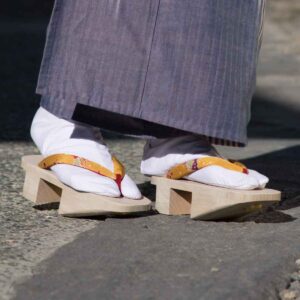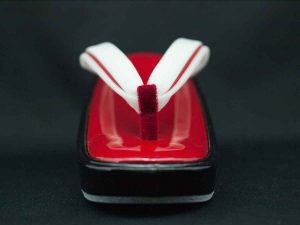Coordinating with Western Clothes
Traditional Japanese footwear is good for your health and beautiful to behold, so we hope you’ll enjoy wearing them with any style of clothing and not just kimonos. They look marvelous with casual clothing, and can make for a compelling ensemble with traditional clothing of other cultures as well. From ancient times in Japan, the saying “putting on geta” has been used to mean making someone or something look even bigger and better. Indeed, geta, the traditional footwear item with raised “teeth” platforms, are much taller than shoes, so wearing them can make you look taller, and your legs appear longer. You might expect such tall footwear to be quite […]
Picturesque Footwear
Another unique feature of Japanese footwear is how it takes advantage of its wide, “picturesque” bases. Some pieces of footwear have ukiyo-e designs printed or motifs of plants, dragons, or tigers engraved on their surfaces. There are even examples of footwear with hand-painted pictures by the artisan on each item, or ones decorated with “maki-e”, a traditional gold and silver lacquering technique; ones embedded with slices of shiny shells in a process called “raden”; or others grafted with leather of varying colors and textures known as “kiritsugi”, and still many other varieties exist. With designs ranging from traditional to modern art motifs, can any other type of footwear boast such […]
Choosing an Authentic Retailer
If you are looking for a quality pair of traditional Japanese footwear, the most important thing is to pick the right store. This is because a true retailer of Japanese footwear doesn’t sell ready-made goods like a standard shoe store. Instead, Japanese footwear retailers offer a unique semi-made-to-order service. The footwear’s base and thongs are made by separate craftsman to create a product that matches each customer’s feet. So, while two given pairs of footwear may look the same, a difference in the fitting of the thong will make them feel completely different when worn. Indeed, a proper footwear artisan must understand how Japanese footwear differs from a standard shoe […]
How to Wear, How to Walk
Putting on and walking in Japanese footwear is a completely new and different experience for most people. This is because they were designed with a totally unique idea of how footwear should fit. With traditional Japanese footwear, The maetsubo, the middle part of the thong which connects to the platform, is not meant to wedge down into the gap between the big toe and the index toe. Instead it is designed to have a slight gap so the thong rests lightly between the toes. An ideal fit is one where the heel extends two or three centimeters over the back end of the platform. When walking, do not land on […]
Footwear for Well-Being from the Feet Up
Our feet contain concentrated areas of peripheral nerves known as “reflex zones,” which affect our entire bodies, including our internal organs. Barefoot living helps stimulate reflex zones, which promotes improved circulation and function of these organs. That being said, we can’t just go out and about barefoot, but we can get close by wearing traditional Japanese footwear. Footwear that does not clamp down on the foot won’t impede circulation. This relaxed fit not only prevents deformation of feet and toes such as bunions, but also strengthens one’s arches. Furthermore, proper wear helps one’s posture, which further improves the shape of one’s whole body. The thong in the center of the […]
No Left or Right in Traditional Japanese Footwear?
While footwear held on by a thong is also seen in other countries such as Southeast Asia and Egypt, the distinguishing characteristic of traditional Japanese footwear is that it has no “left” or “right.” When trying to create footwear that fits the feet well, it’s natural to make a difference between the left and right sides. Surely the skilled craftsmen of Japan are capable of doing so too, yet this lack of left and right continues to this day. Why is there no difference between left and right in the long history of Japanese footwear? The Japanese concept of footwear differs greatly from a shoe or a sandal. Inside their […]
Types of Japanese Traditional Footwear
Footwear items from Tsujiya Honten are all one-of-a-kind, semi-made-to-order products. With such a variety of designs from a simple shape, they are truly a work of Japanese traditional art and just looking at them brings joy. Geta -下駄- Wooden base footwear fit with a thong. Originally crafted in ancient Japan as a tool for work, they later became fashionable footwear. A wide variety of platforms exist depending on the shape of the “teeth.” They are more suited towards everyday wear than zouri. Materials used include pine and cedar, but Tsujiya Honten mainly sells those made with the light, highly absorbent paulownia wood, as it is the highest quality material for […]
Traditional Japanese Footwear -The ancient secret to well-being from the feet up-
Throughout the whole of Japan’s considerable history, thong-style footwear of one type or another has been worn. Though obviously different from shoes, Japanese open-toed footwear is also different from sandals developed elsewhere in that they were designed based on a uniquely original idea. The feet are considered the key to staying healthy and it is upon this secret which Japanese traditional footwear evolved. The ancient secret to well-being from the feet up Throughout the whole of Japan’s considerable history, thong-style footwear of one type or another has been worn. Though obviously different from shoes, Japanese open-toed footwear is also different from sandals developed elsewhere in that they were designed based […]











